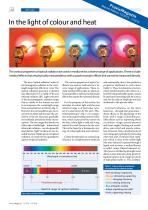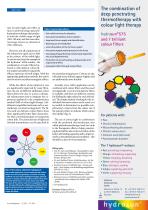 Website:
Hydrosun Medizintechnik
Website:
Hydrosun Medizintechnik
Catalog excerpts

The various properties of optical radiation are used in medicine for a diverse range of applications. These include medical effects that are physically measureable as well as psychosomatic effects that cannot be measured directly. 380 4CO 420 440 460 460 500 S20 540 560 580 600 620 640 860 680 700 720 740 780 780 The term “optical radiation” refers to electromagnetic radiation in the wavelength range from 100 nm to 1 mm. The optical radiation spectrum is divided into ultraviolet (UV), visible (VIS) and infrared radiation (IR). Light is the part of the electromagnetic radiation range that is visible to the human eye and it encompasses the wavelength range from around 380 nm to 780 nm (fig. 1). However, it is not possible to give an exact limit on either side because the sensitivity of the eye decreases gradually, not suddenly, around the limits of perception. The two ranges that border on either side of visible light - infrared and ultraviolet radiation - are also generally described as “light”. So there are two invisible and one visible spectra of optical radiation. So much for the quantitative aspects of optical radiation. The various properties of optical radiation are used in medicine for a diverse range of applications. These include medical effects that are physically measureable as well as psychosomatic effects that cannot be measured directly. For the purposes of this article, the interplay of colour light and the near infrared range is of particular interest; it is also known by the term “Photothermotherapy” (fig. 1). In comparison to heat-generating infrared radiation, which is perceived by sensors on the skin, colour light is cold and is registered first and foremost by the eyes. This is the basis for a therapeutic synergy of colour light and near infrared. Colour therapy takes on a special significance in complementary medicine and naturopathy due to the qualitative properties attributed to each colour (table 1). These mechanisms of action, which predominantly take effect on a level beyond ponderable matter, cannot be measured metrologically by science and, for the sake of simplicity are thus attributed to the placebo effect. Infrared radiation, on the other hand, has - through heat generation -direct effects on the physiology of the body, with a range of desirable possible effects such as improving blood circulation, oxygen partial pressure and tissue supply, flushing out metabolites, pain relief and muscle relaxation. However, from a medical point of view things get particularly interesting when that part of infrared heat radiation which is close to the visible light (the near infrared) is passed through a liquid such as water, a method known as wIRA (water-filtered infrared-A). This process of filtering through water allows a more intensive, deep-penetrating heat input to treat a large spectrum of indications (table 2). The combina- invisible visible Table 1: Colour effects attributed according to the chakra system Spectral range of optical radiation • Red: activating, invigorating • Orange: stimulating, supporting • Yellow: changing, dissolving • Green: calming, balancing • Blue: antiseptic, cooling • Indigo: regulating, pain relief • Violet: supporting, relaxing
Open the catalog to page 1
tion of colour light and wIRA, in turn, is achieved using a special illumination technique that produces both the visible range of light (380–780 nm) and the near infrared range, known as infrared-A (780–1400 nm). Table 2: Typical wIRA effects • Pain relief and muscle relaxation • Increased metabolism and circulation • Improved tissue supply and detoxification • Washing out of metabolites • Local stimulation of the immune system The combination of deep penetrating thermotherapy with colour light therapy hydrosun®575 and 7 brilliant colour filters • Increased oxygen partial pressure in the...
Open the catalog to page 2All Hydrosun Medizintechnik catalogs and technical brochures
-
IR penetration depth
1 Pages




